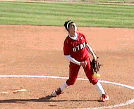|
by Gerald Warner,
Softball Pitching Instructor

It’s a great dream…a
young pitcher throwing the infamous rise ball. Pitchers and their parents
like to brag about how many pitches they throw…even though all of
them often look alike with no movement at all. A true rise ball is not
merely a pitch that is released low and thrown to a chin-high
spot. We discuss the
correct spin direction, the
very fast spin speed, and fast pitch speed
required for a “legitimate” rise ball.
In 20 years of training scores of pitchers of all ages
and observing thousands more we are yet to see a pre-teen pitcher
with a true “moving” rise ball. Many young pitchers have
been misled…and some even hurt…by consistently trying to throw a
riser before they are capable of doing it. It doesn’t work for a young
pitcher…and here is why:
Many people
who give pitching lessons try to teach a rise ball release to young
pitchers without disclosing the very small potential of
success (and the real risk of injury when
practicing the hard wrist snap) . By attempting to teach the
rise ball to a young girl, it (1) gives false hope to the
pitcher, (2) has her and her parents “thinking”
that she can throw a rise ball, but (3) keeps the pitcher going back
to the instructor for more lessons.

Consequently, a sizeable
percentage of pitchers, even older experienced
ones, do not even know the direction that a
rise
(or even a drop ball, curve, or screw
ball) needs to spin in order to cut into the air to make the
ball go in a specific direction. And a rise ball, in order to
really move, needs to be spinning bottom-to-top at almost
twice the speed of a drop ball. And even with good spin, for
a rise ball to work right it needs to be thrown at a speed at least
in the mid-50’s…and preferably 60+ mph. Former Olympian and ESPN
softball announcer Michele Smith feels that the
best speed for a good rise ball is between 61 and 65 mph.
Classic form for a good
rise ball release
We have seen many team
coaches of 10U, 12U, and even some 14U teams, thinking that a
pitcher has a rise ball simply because she throws high pitches,
calls for the rise pitch to be thrown during games. And then, when the pitch
simply comes in as a high flat fast ball, blames the pitcher every
time an opposing batter connects with it. Good rise ball pitchers
often place their rise ball at mid-thigh on the
batter…provided it has good rise ball spin, spin speed, pitch
speed, and movement.
Most responsible
pitching instructors will wait until a pitcher is ready…in terms of
ability, pitch speed, and commitment… before having her to start
working on a rise ball.
For some, that might be at 14 or 15-years old…others much
later.
See also these pages
on the PitchSoftball.com website:
http://pitchsoftball.com/RiseBallSecrets.html
http://pitchsoftball.com/Page11.html
http://pitchsoftball.com/AllPitchesHaveanArc.html
____________________________________________________________
This article above can be downloaded and
printed from Microsoft Word

Do you want to reprint this
article or use it on your website or in your
newsletter?
As long as it is not for profit,
our only requirement is that you first notify us, then include the
following sentence:
Article by Gerald Warner of
PitchSoftball.com
and include a reference to this
website: www.pitchsoftball.com
If you have questions or
need more information
E-mail us, or
call Pitching Instructor Gerald Warner in Colorado at
(720) 200-4575
PitchSoftball Home Page | About Us | Beginning Pitchers | 1st & 2nd Year
Pitchers | Advanced Pitchers | Coaches and Parents
Recent Questions and
Recommendations | Search by
Keywords | 











